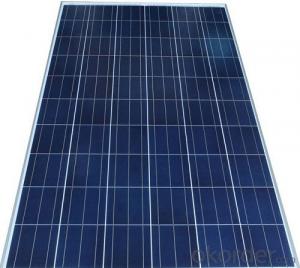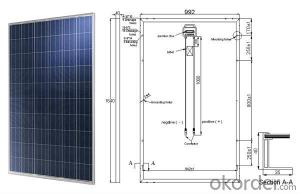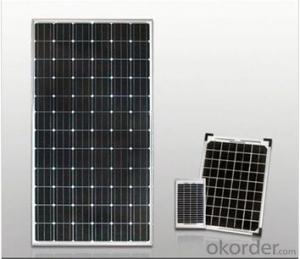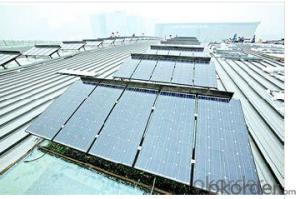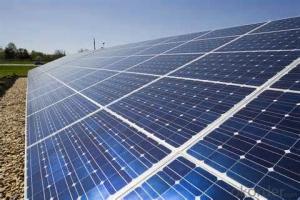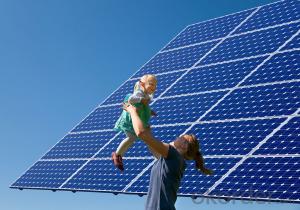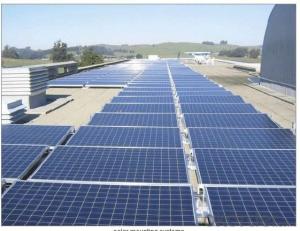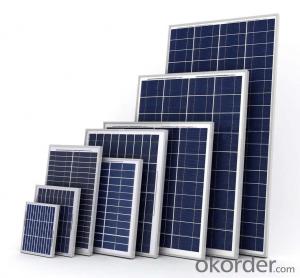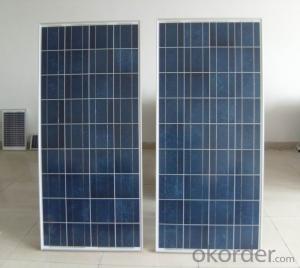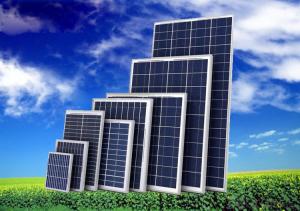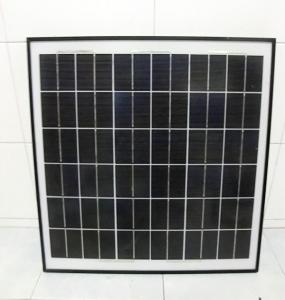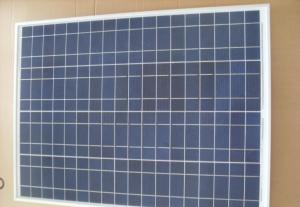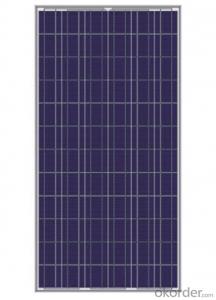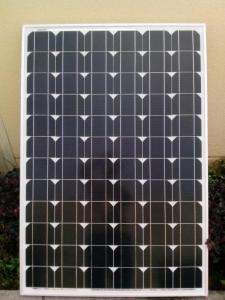12V Battery Charging Solar Panels with High Quality and Efficiency Poly295W
- Loading Port:
- Shanghai
- Payment Terms:
- TT OR LC
- Min Order Qty:
- 10000 watt
- Supply Capability:
- 100000000 watt/month
OKorder Service Pledge
OKorder Financial Service
You Might Also Like
Specification
1.Product Description:
Solar Module is the core part of solar PV power systems, also is the highest value part of it. The function of Solar Module is to convert the sun's radiation to electrical energy, or transfer it to battery and store in it, or to drive the load running.The Product has been widely used in space and ground, it mainly used for power generation systems, charging systems, road lighting and traffic signs areas. It could offer a wide range of power and voltage, and with high conversion efficiency, and long service life.
2. Standard Test Conditions of Polycrystalline Silicon Solar Panel:
The opto-electrical specifications shown below are stabilized values being measured at Standard Test Conditions, Irradiance: 1000W/m2, Spectrum: AM1.5 at 25°C, The info below is subject to manufacturing tolerances. Where appropriate minutes of measurement are available and are used for the dimensioning of the installation.
Advantages of Polycrystalline Silicon Solar Panel
• CNBM Solar performance guarantees for 25 years
• 12 years guarantee for workmanship
• Timeliness of delivery
• Quality Products certified (TÜV, UL, CE, ISO)
3. Production Flow
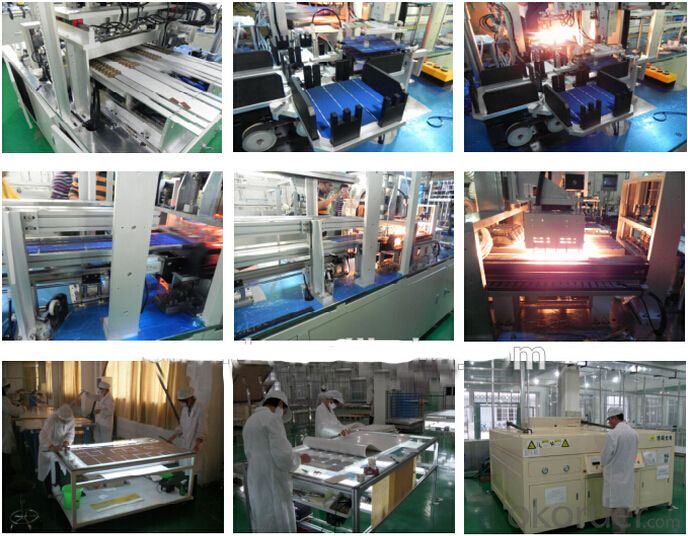
4. The Pictures of Products

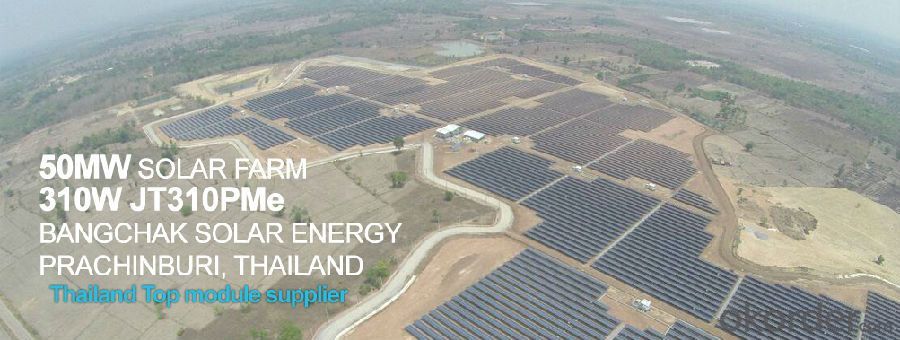

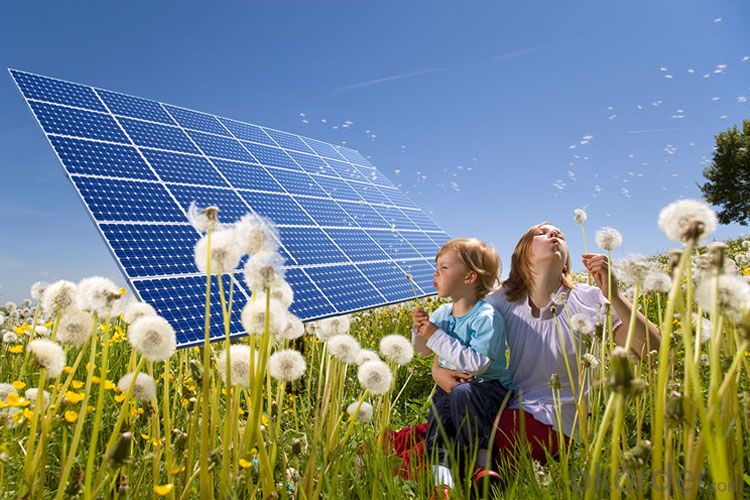
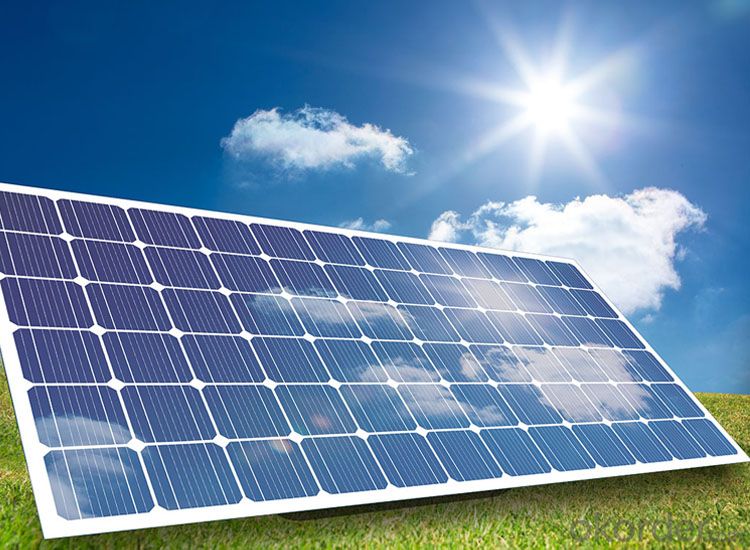
5. FAQ
We have organized several common questions for our clients,may help you sincerely:
1. How about your company
CNBM Solar photovoltaic (PV) Panel has various wattage from 1.5W to 315W to meet the demand of every customer. It is the optimal choice for both on-grid and off-grid power systems. CNBM Solar panel offers high performance of power warranty and good after sale service, we have professional people to reply your problem anytime.
2. What’s price per watt?
A: It’s depends on the quantity, delivery date and payment terms of the order. We can talk further about the detail price issue. Our products is high quality with lower price level.
3. How do you pack your products?
We have rich experience on how to pack the panels to make sure the safety on shipment when it arrives at the destination.
4. Can you do OEM for us?
Yes, we can.
5. How long can we receive the product after purchase?
In the purchase of product within three working days, We will arrange the factory delivery as soon as possible. The perfect time of receiving is related to the state and position of customers. Commonly 7 to 10 working days can be served.
- Q: I need to find a way to clean solar panels that automated, at best;A way beside using a large 'squeegee'
- Hire Tinkerbell, Disney hasn't had much for her to do lately.
- Q: We want make solar panel for our home use. but we have no any right idea how we can make it. we want to make it with cheap prices.we also want to know the proper size of solar panel.where we can take help about making a solar panel
- Create okorder
- Q: What does it take to install the solar panel? Cable wires to power source or fuse box? Anything else?How does the cable wires stay on the solar panel?
- How does the cable wires stay on the solar panel? With wire retention clips (4 per module) that are used to wrap the wire on the underside of the module frame. The home run cables to the transition box (converts between types of wire with no electrical transformation occuring) or combiner box (joins multiple source circuits in parallel, with the positives fused for safety) are usually tied along the racking system components, and with conduit sections used as needed. Racking is another big part of the installation. Don't just make your own homemade wooden rack, as these will weather away to nothing very easily, and cause great failures. GET a professionally designed metal racking system. PV modules are EXPENSIVE. Don't let the racking system cause them to break. It also requires the inverter, if you intend it to connect to the main electric service. If using multiple inverters, you need an AC combining panelboard to join them prior to entering the main electric service. Otherwise, you need to think about how else you might be using them. If you are charging batteries, you need a charge controller.
- Q: What would these solar panels power? For instance, my energy bill shows 2035kWh for last month. How much would this remove from that if it outputted full power? Thanks!
- A solar panel that is rated at 60 watts would produce that amount under the most favorable conditions of direct sunlight at noon in a good location. This would taper off to nothing at the beginning and ends of the daylight. A 60 watt Panel operating at full output for hour would produce 60 watt hours. If we assumed a straight line of output from zero to 60 watts and back to 0 again over 6 hours the average output would be 30 watts x 6 hours = 80 watt hours / day x 365 days = 65700 watt hours in a year / 2 = 5475 watt hours in a month. You lose about 0% converting from DC to AC. This reduces this to about 4927.5 watt hours. Your bill is measured in KW hr which are 000 times bigger. This is 4.9275 KW hr or .24% of your last month's bill. At a national average of about $.2 per KW hr the energy out put for one month would be equal to about 60 cents.
- Q: How long do solar panels last?
- Solar panels typically have a lifespan of around 25 to 30 years. However, with proper maintenance and care, they can last even longer.
- Q: Can solar panels be installed on a theme park or amusement park?
- Yes, solar panels can be installed on a theme park or amusement park. In fact, many theme parks around the world have already installed solar panels to generate clean and renewable energy. This not only helps to reduce their carbon footprint and dependence on fossil fuels but also saves them money on electricity bills in the long run. Additionally, solar panels can be integrated into the design of the park, complementing its aesthetic appeal and showcasing the park's commitment to sustainability.
- Q: I want to also know if the 0 watt rating on the solar panel is 0 watts per day or is it constantly adding 0 watts? Is there a time which the 0 watts is being added like 0 watts per second or 0 watts per minute and so on?
- 0 Watt Solar Panel
- Q: Can anyone tell me how to connect a solar panel from a calculator to a motor from an RC car.
- Solar Rc Car
- Q: I am thinking of buying a 3w solar panel called the nomad 3 from goal zero. I want to charge 35Wh lithum batteries. I have heard that lithium batteries are temperatmental and without a regulated current things could get ugly.I have a couple of chargers that came with the batteries. One is a 2v car charger and another is 0-240v wall charger.Goal zero sell something called a sherpa 50, which contains rechargeable batteries and an inverster and I think they suggest that I charge my batteries indirectly through the Sherpa 50, however, the sherpa 50 is expensive at $200, and seems to have a small capacity, in addition to being extra weight that i don`t want to carry.Electronics geniuses, you are my only hope.
- Lithium batteries do have special charging requirements. I would recommend that you use the 2 volt charger that came with them to keep them happy. Automotive power systems can have voltages as high as 4.5 volts when the engine is running so there's no need to limit the output of the panel to anything less than that. Check with the charger manufacturer to see what it will withstand. Some will work with systems up to 24 volts nominal (up to 29 volts actual) found in larger commercial vehicles such as trucks and busses. If your charger will work with both 2 and 24 volt systems you might not need anything extra to use the unregulated output of the panel. Otherwise I'd recommend a shunt regulator to clamp the output of the panel to no more than 4.5 volts. That way it would dissipate (waste) very little of the panel's power, and even that would only be during those rare times when the panel is producing maximum output. Such a device could be as simple as a high power zener diode, a low power zener coupled with a power transistor, or a precision shunt regulator such as a TL43 coupled with a power transistor. A more complex way would be a to use buck/boost regulator between the panel and your charger. You might gain a slight advantage under low light conditions when the panel isn't putting out much but the overall efficiency could end up worse than the simpler shunt regulator. Under optimum conditions, I would expect it to take a full day for a 3 watt (peak) panel to charge just one of your 35 Wh batteries. Charging an intermediate device such as the Sherpa 50 through its built in charger and then using it to charge your battery through yet another charger would severely cut your overall efficiency. Depending on how long you'll be gone, it might be far more practical, reliable, and economical to just carry (or find a way to be resupplied with) a few additional fully charged 35 Wh batteries. Don
- Q: How do solar panels affect the property's carbon footprint?
- Solar panels can significantly reduce a property's carbon footprint by generating clean and renewable energy from the sun. Since solar panels produce electricity without emitting harmful greenhouse gases, they help to offset the carbon emissions associated with traditional energy sources. By using solar energy, properties can reduce their reliance on fossil fuels and make a positive impact on the environment by reducing their carbon footprint.
Send your message to us
12V Battery Charging Solar Panels with High Quality and Efficiency Poly295W
- Loading Port:
- Shanghai
- Payment Terms:
- TT OR LC
- Min Order Qty:
- 10000 watt
- Supply Capability:
- 100000000 watt/month
OKorder Service Pledge
OKorder Financial Service
Similar products
Hot products
Hot Searches
Related keywords
